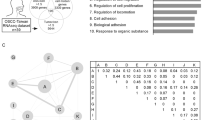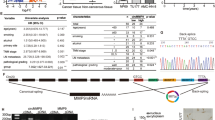Abstract
Microarray RNA gene expression profiling analysis has shown that Sox4 (Sry-related high mobility group (HMG) box 4) is one of the most upregulated genes in adenoid cystic carcinoma (ACC), relative to non-neoplastic tissue of origin. Here, we show that Sox4 protein is similarly upregulated in ACC by immunohistochemistry of 28 primary cancers and 20 normal tissues. To elucidate the functional significance of these findings, RNA interference (RNAi)-mediated RNA silencing was used to downregulate Sox4 expression in the ACC-derived cell line, ACC3. With confirmed knockdown of Sox4 protein, cell viability was reduced by 51%, with a corresponding increase of apoptosis to 85% as compared to 12% in controls. Apoptosis was confirmed by cell morphology, DNA fragmentation and flow cytometry. Cells could be rescued from the proapoptotic effects of Sox4 RNAi by co-transfection with a construct expressing functional Sox4. Microarray gene expression profiling of RNAi knockdown experiments shows that downregulation of Sox4-modulated expression of critical genes involved in apoptosis and cell cycle control. Overall, our findings suggest that Sox4 contributes to the malignant phenotype of ACC cells by promoting cell survival.
This is a preview of subscription content, access via your institution
Access options
Subscribe to this journal
Receive 50 print issues and online access
$259.00 per year
only $5.18 per issue
Buy this article
- Purchase on Springer Link
- Instant access to full article PDF
Prices may be subject to local taxes which are calculated during checkout









Similar content being viewed by others
References
Berns K, Hijmans EM, Mullenders J, Brummelkamp TR, Velds A, Heimerikx M et al. (2004). Nature 428: 431–437.
Boyd JM, Malstrom S, Subramanian T, Venkatesh LK, Schaeper U, Elangovan B et al. (1994). Cell 79: 341–351.
Cheng J, Irie T, Munakata R, Kimura S, Nakamura H, He RG et al. (1995). Virchows Arch 426: 577–586.
Doench JG, Sharp PA . (2004). Genes Dev 18: 504–511.
Du Y, Spence SE, Jenkins NA, Copeland NG . (2005). Blood 106: 2498–2505.
Evan GI, Vousden KH . (2001). Nature 411: 342–348.
Farr CJ, Easty DJ, Ragoussis J, Collignon J, Lovell-Badge R, Goodfellow PN . (1993). Mamm Genome 4: 577–584.
Frierson Jr HF, El-Naggar AK, Welsh JB, Sapinoso LM, Su AI, Cheng J et al. (2002). Am J Pathol 161: 1315–1323.
He RG, Zhang XS, Zhou XJ, Wang Z, Zhang XL, Qiu WL et al. (1988). West Chin J Stomatol 6: 1–4.
Hunt SM, Clarke CL . (1999). Biol Reprod 61: 476–481.
Hur EH, Hur W, Choi JY, Kim IK, Kim HY, Yoon SK et al. (2004). Biochem Biophys Res Commun 325: 59–67.
Igney FH, Krammer PH . (2002). Nat Rev Cancer 2: 277–288.
Jackson AL, Bartz SR, Schelter J, Kobayashi SV, Burchard J, Mao M et al. (2003). Nat Biotechnol 21: 635–637.
Jiang X, Kim HE, Shu H, Zhao Y, Zhang H, Kofron J et al. (2003). Science 299: 223–226.
Kan L, Israsena N, Zhang Z, Hu M, Zhao LR, Jalali A et al. (2004). Dev Biol 269: 580–594.
Kimura S, Cheng J, Toyoshima K, Oda K, Saku T . (1999). J Biochem (Tokyo) 125: 406–413.
Lu HF, Sue CC, Yu CS, Chen SC, Chen GW, Chung JG . (2004). Food Chem Toxicol 42: 1543–1552.
Lund AH, Turner G, Trubetskoy A, Verhoeven E, Wientjens E, Hulsman D et al. (2002). Nat Genet 32: 160–165.
McCracken S, Kim CS, Xu Y, Minden M, Miyamoto NG . (1997). Oncogene 15: 2929–2937.
McEleny K, Coffey R, Morrissey C, Fitzpatrick JM, Watson RW . (2004). BJU Int 94: 402–406.
Munakata R, Irie T, Cheng J, Nakajima T, Saku T . (1996). J Oral Pathol Med 25: 441–448.
Nguyen JT, Wells JA . (2003). Proc Natl Acad Sci USA 100: 7533–7538.
Panda DK, Miao D, Lefebvre V, Hendy GN, Goltzman D . (2001). J Biol Chem 276: 41229–41236.
Reichling T, Goss KH, Carson DJ, Holdcraft RW, Ley-Ebert C, Witte D et al. (2005). Cancer Res 65: 166–176.
Rhodes DR, Yu J, Shanker K, Deshpande N, Varambally R, Ghosh D et al. (2004). Proc Natl Acad Sci USA 101: 9309–9314.
Schilham MW, Oosterwegel MA, Moerer P, Ya J, de Boer PA, van de Wetering M et al. (1996). Nature 380: 711–714.
Schmahl J, Eicher EM, Washburn LL, Capel B . (2000). Development 127: 65–73.
Sledz CA, Holko M, de Veer MJ, Silverman RH, Williams BR . (2003). Nat Cell Biol 5: 834–839.
Sowter HM, Ratcliffe PJ, Watson P, Greenberg AH, Harris AL . (2001). Cancer Res 61: 6669–6673.
Su AI, Welsh JB, Sapinoso LM, Kern SG, Dimitrov P, Lapp H et al. (2001). Cancer Res 61: 7388–7393.
Suzuki T, Shen H, Akagi K, Morse HC, Malley JD, Naiman DQ et al. (2002). Nat Genet 32: 166–174.
Tamm I, Wang Y, Sausville E, Scudiero DA, Vigna N, Oltersdorf T et al. (1998). Cancer Res 58: 5315–5320.
van de Wetering M, Clevers H . (1992). EMBO J 11: 3039–3044.
van de Wetering M, Oosterwegel M, van Norren K, Clevers H . (1993). EMBO J 12: 3847–3854.
Van Huffel S, Delaei F, Heyninck K, De Valck D, Beyaert R . (2001). J Biol Chem 276: 30216–30223.
Vande Velde C, Cizeau J, Dubik D, Alimonti J, Brown T, Israels S et al. (2000). Mol Cell Biol 20: 5454–5468.
Vander Poorten VL, Balm AJ, Hilgers FJ, Tan IB, Loftus-Coll BM, Keus RB et al. (1999). Cancer 85: 2255–2264.
Wegner M . (1999). Nucleic Acids Res 27: 1409–1420.
Welsh JB, Sapinoso LM, Su AI, Kern SG, Wang-Rodriguez J, Moskaluk CA et al. (2001). Cancer Res 61: 5974–5978.
Wertz IE, O'Rourke KM, Zhou H, Eby M, Aravind L, Seshagiri S et al. (2004). Nature 430: 694–699.
Acknowledgements
We thank all of the participants of the Adenoid Cystic Carcinoma Tumor Registry for their contributions of tissue specimen and support of our research efforts. We thank Angela Miller and Sharon Birdsall for assistance with histologic and immunohistochemical techniques. This work was supported by a grant from the National Institute of Dental and Craniofacial Research (R01-DE-14694).
Author information
Authors and Affiliations
Corresponding author
Rights and permissions
About this article
Cite this article
Pramoonjago, P., Baras, A. & Moskaluk, C. Knockdown of Sox4 expression by RNAi induces apoptosis in ACC3 cells. Oncogene 25, 5626–5639 (2006). https://doi.org/10.1038/sj.onc.1209566
Received:
Revised:
Accepted:
Published:
Issue Date:
DOI: https://doi.org/10.1038/sj.onc.1209566
Keywords
This article is cited by
-
FHL3 links cell growth and self-renewal by modulating SOX4 in glioma
Cell Death & Differentiation (2019)
-
DownRegulated SOX4 Expression Suppresses Cell Proliferation, Migration, and Induces Apoptosis in Osteosarcoma In Vitro and In Vivo
Calcified Tissue International (2018)
-
The lncRNA CASC15 regulates SOX4 expression in RUNX1-rearranged acute leukemia
Molecular Cancer (2017)
-
SOX4 is a potential prognostic factor in human cancers: a systematic review and meta-analysis
Clinical and Translational Oncology (2016)
-
SOX4 expression is associated with treatment failure and chemoradioresistance in oral squamous cell carcinoma
BMC Cancer (2015)



